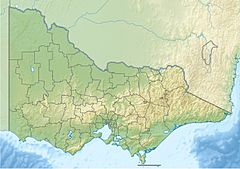Yalmy River facts for kids
Quick facts for kids Yalmy |
|
|---|---|
| Other name(s) | Broadbent Creek |
| Country | Australia |
| State | Victoria |
| Region | Australian Alps (IBRA), Victorian Alps, East Gippsland |
| LGA | Shire of East Gippsland |
| Physical characteristics | |
| Main source | Yalmy State Forest Snowy River National Park 476 m (1,562 ft) |
| River mouth | confluence with the Rodger River east of Hicks campsite 161 m (528 ft) 37°24′42″S 148°23′21″E / 37.41167°S 148.38917°E |
| Length | 28 km (17 mi) |
| Basin features | |
| River system | Snowy River catchment |
| Tributaries |
|
| National park | Snowy River NP |
The Yalmy River is a cool, flowing river in the Australian Alps. It's located in Victoria, a state in Australia. This river is part of the larger Snowy River system. It flows all year round, which is why it's called a perennial river.
Contents
Where the Yalmy River Flows
The Yalmy River starts its journey in a quiet, wild area. This area is where the Snowy River National Park meets the Yalmy State Forest. It begins high up, about 476 meters (1,562 feet) above sea level.
River's Journey
The river flows mostly south, then west, and then south again. Along its way, three smaller streams join it. These smaller streams are called tributaries. Finally, the Yalmy River meets another river, the Rodger River. This meeting point is called a confluence. It happens inside the national park, east of a place called Hicks camp site.
River's Length and Drop
The Yalmy River travels about 28 kilometers (17 miles) from where it starts to where it joins the Rodger River. During this journey, it drops 315 meters (1,033 feet) in height. That's like going down a very tall building!
Yalmy River and the National Park
The entire Yalmy River flows either inside the Snowy River National Park or forms its eastern border. This means the river is protected within a beautiful natural area. The national park helps keep the river and its surroundings safe for plants and animals.
Traditional Owners of the Land
The land around the Yalmy River has been home to Australian Aboriginal people for a very long time. The traditional custodians of this area are the Bidawal and Nindi-Ngudjam Ngarigu Monero peoples. They have a deep connection to this land and its rivers.


